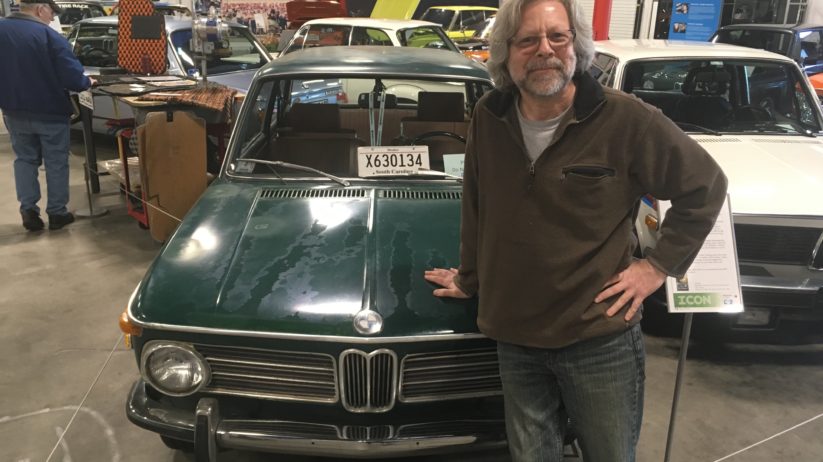Last week, after driving down to Greer with my friend Andrew Wilson to attend the closing ceremony of the “2002 ICON” exhibit at the BMW CCA Foundation and retrieve Louie after his 11-month stay there, I left with you with a cliffhanger on not one but two issues: 1) Would I be able to fix Louie’s clutch, and if so, 2) Would the impending bad weather permit me to drive Louie home?
Yes and no.
We’re done. Closing time. You can’t stay here. Remember to tip your bartenders and waitresses.
Sorry. It’s been a long week.
Let’s deal with the clutch first.
As I said last week, because Foundation curator Michael Mitchell told me that Louie wouldn’t shift into any gear with the engine running, I’d ordered a clutch slave and master and had them shipped down ahead of me. I didn’t think I’d need them—I had replaced them both two years ago when I’d resurrected the car in Louisville—but I’ve largely learned the lesson that, whenever I think “well it can’t be that,” I’m admitting I have a blind spot around “that.” I regarded the $110 for the master and slave as cheap blind spot insurance since, if I needed the parts and didn’t have them, there’d be no way to procure them in Greer without a wait of several days. But really, I thought the problem was more likely due to air in the line or a stuck clutch disc.
When I arrived at the Foundation on mid-Friday afternoon, I almost immediately ran into Mario Langsten from VSR1. Mario was aware of Louie’s clutch problem and was in his help-folks-fix-cars mode. I don’t think I’d been in the building 30 seconds when Mario grabbed me and said “Stick your head under Louie while I hit the clutch pedal. Check if the slave cylinder moves the clutch release lever.” I did, he did, and it did. (Actually, there was a little more drama than that. I scooched Louie under from the side, and when Mario, who weights more than I do, sat in the car, the suspension dropped noticeably, and I said “can’t… breathe…” Mario got out, I extricated myself, then slid under the front where there was more room. I then verified that the clutch slave moved the clutch release lever without the danger of my rib cage being collapsed.)
Since the clutch lever moved, it appeared that the clutch disc was stuck to the flywheel. That was the state that I’d found the car in when I’d bought it two years ago after it’d sat for a decade. I found it unusual that the clutch re-stuck after sitting for less than a year in a climate-controlled building, but that’s where the diagnosis seemed to lead.
In order to break the clutch disc free from the flywheel, I needed to start the car in gear with my foot on both the brake and the clutch. The problem was that there was a line of four museum-quality 2002s (this was, after all, a museum) not ten feet in front of Louie. If the car somehow accidentally started while in gear… disaster. So, to do this safely, I needed to pull Louie out of its parking space and move it away from the other cars. I’d already arranged with Michael Mitchell that, if I needed to jack up the car and work on the clutch, I’d do it on Saturday morning. So that Friday, I just puttered around a bit with Louie, spraying some brake cleaner down the timing ball inspection hole to help the presumably-stuck clutch free up, and installing fresh plug wires and wiper blades.

These beauties were directly in front of Louie. I did NOT want to inadvertently crash into one of them.
On Saturday morning, Michael Mitchell, a few other volunteers and I put the Go-Jack wheel dollies in place around Louie, extracted him from his tight parking space in the ICON display, and rolled him into “the tunnel” that leads out the back of the Foundation. Once there, I opened up the garage door, warmed the car up for about ten minutes, then made several attempts at starting it in gear with the brake and clutch pedals depressed to break the stuck clutch free. I had no success.
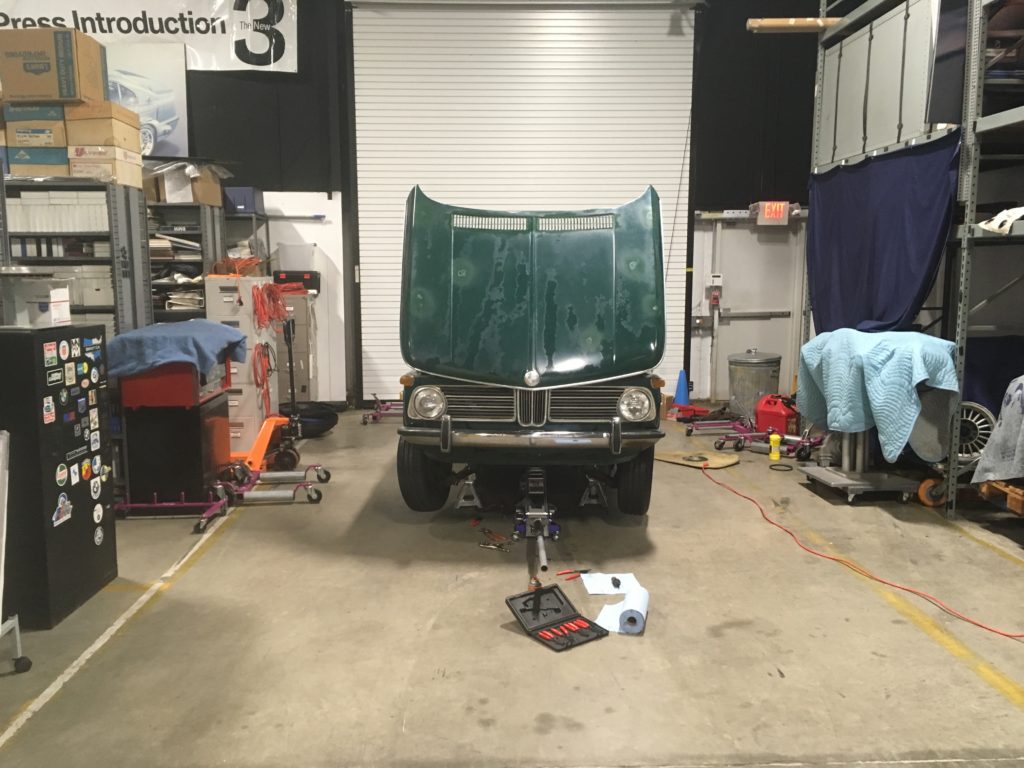
I worked on Louie in “the tunnel” of the Foundation. In no time, I had Hacked the place up, making it look like home :^)
While this was going on, Safet Hatic, the mechanic who works with collector Lance White (Lance had several cars in the exhibit) wandered over and asked me how it was going. Safet, along with other people like Mario and Terry Sayther, have forgotten more than I’ll ever know about working on vintage BMWs, so I take his input very seriously. I described what I’d found thus far. Safet expressed surprise that, if the clutch was indeed stuck, it hadn’t broken free.
“Have you bled it?” he asked. I answered in the negative, saying I didn’t think it was necessary since I saw the slave move. Safet said “You really ought to bleed it to be certain there’s no air preventing the slave from reaching its full extension.” He was right. So with Safet at the pedal, I bled the clutch, but it made no difference. We both scratched our heads.
“Are you sure that slave cylinder is moving?” Safet quizzed me. “I’ll look at it again,” I said. With the car jacked up and sitting securely on stands, I crawled under while Safet mashed the pedal, and it was then that I saw the problem. When Safet depressed the clutch pedal, initially the slave cylinder’s rod extended and moved the clutch release lever, but instead of staying in that extended position while the pedal was depressed, the rod quickly retracted back into the slave, allowing the lever to release the clutch. It can be seen in this video. No wonder Louie couldn’t be put in gear. When, the previous day, I’d crawled under it and Mario hit the pedal, I’d been too quick. I saw that the slave moved, but I didn’t verify that it moved correctly. Live and learn.
The failure mode pointed pretty clearly to hydraulic failure. The obvious step was to install the new hydraulics I had shipped down. Having planned for the worst-case scenario: Yay! Having to perform the work to fix the worst-case scenario: Boo! (Actually, I take that back—the real worst-case scenario would’ve been something like broken fingers on the clutch plate that required pulling the transmission.)
I began with the slave cylinder because, well, it’s easier to change than the master cylinder. Now, having said that, easier doesn’t mean easy. Right off the bat, I realized that I didn’t have a set of snap ring pliers I needed to remove and install the slave, and there wasn’t one in the Foundation’s tool chest either. Fortunately Michael Mitchell had a set at home, and his dad, my old friend Rob Mitchell, retrieved them for me.
The slave came out without too much of a fight (after all, it hadn’t even been in there for two years), but I’ve found installing slaves to be a little tricky. It’s easy if the transmission is out of the car, but when it’s in the car with the release lever in place, I’ve found I need to remove the boot and the push-rod, position them and the snap ring in the back side of the bell housing hole with the end of the push-rod in the clutch release lever hole, slide the slave and its already-fitted snap ring and tabbed spacer into the front side of the bell housing hole, then slide the opening in the end of the slave over the push-rod. You then need to continue to press the slave toward the back, with the push-rod pressing against the pressure of the internal spring behind the slave’s piston, and at the same time fit the rear snap ring into position. A big C-clamp or big slip-joint pliers helps, and I had neither. While you’re doing this, you need to get the tab on the oddly-shaped spacer that slides around the outside of the slave to slide into position in a notch in the half-moon-shaped lower bell housing cover. For the life of me I couldn’t get the tab lined up with the notch, which meant I couldn’t expose the groove for the snap ring. I finally remembered that I had this same problem two years ago in Louisville, and the answer was to remove the bell housing cover, install the slave, and then put the cover back on. So I did all that, bled it, and then tried the clutch.
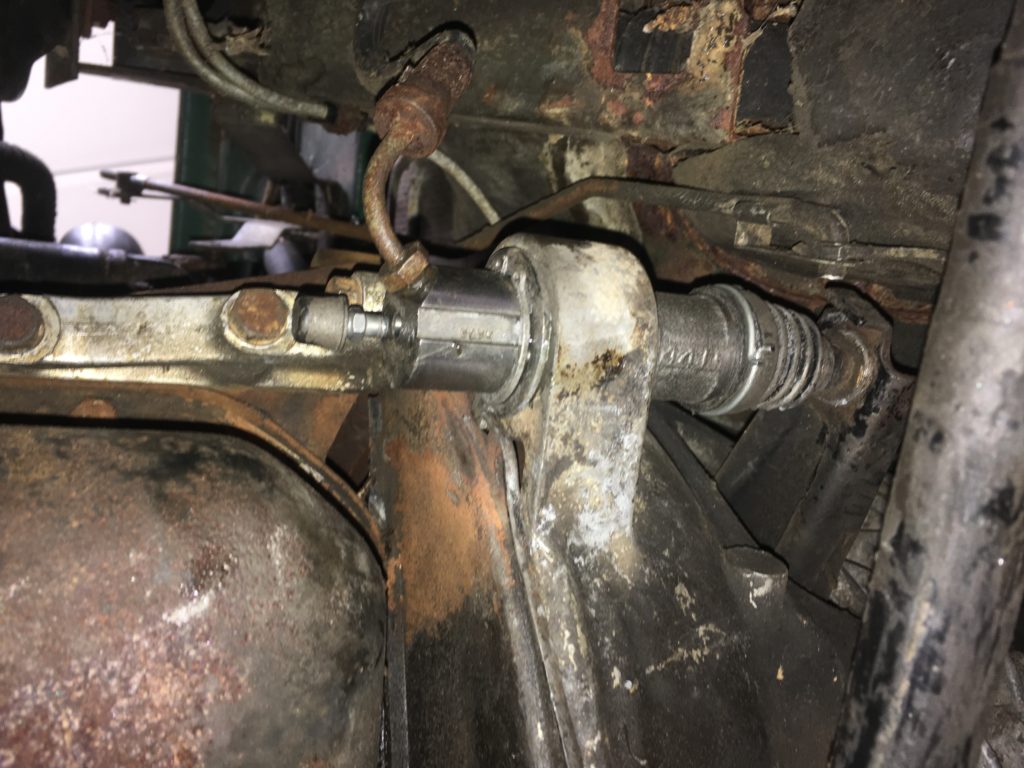
The newly-replaced slave cylinder, snap ring, troublesome tabbed spacer, and bell housing cover.
Unfortunately it made no difference; the new slave cylinder also did the premature relaxation thing.
By this time, it was 1:30 pm. The Foundation requested that I stop work at 4:30 to allow ample time to clean things up and move Louie back into position for the closing celebration at 6:30. I didn’t have any question that I’d be able to change the master in three hours (I’d done it on Louie two years ago, and on Bertha just this past fall), but it was still a bit of a slog.
The first thing that happened in the repair was downright funny. To fish the master cylinder in and out of the engine compartment, I needed to remove the tii’s air cleaner. It’s held in place by four 10mm bolts. I’m sure you already know where this is going. There are myriad memes relating to the fact that, above all others, it’s the 10mm sockets that get lost. True to their reputation, I began to undo the first bolt, my 10mm socket fell off the end of its 1/4″ ratchet handle, and did not hit the floor, undoubtedly landing on the top of the left frame rail and rolling backward into the crevice at the base of the firewall that we all know is a portal to another dimension. Then I borrowed another 10mm socket from the Foundation’s tool kit, and two minutes later, the exact same thing happened. So, Michael Mitchell, I owe you a 10mm socket.
Because the clutch master cylinder is bolted to the firewall, removing it usually takes one person inside the car with a ratchet wrench and a second one under the car with a box-end. I borrowed Foundation volunteer Kyle van Hoften to do in-car ratchet duty while I held the nuts still from underneath. I removed the two-year-old master, transferred the metal pipe over to the new one, and lowered it into place. When it came time to bleed the brakes and verify correct hydraulic operation, I flagged down a passing Jackie Jouret (and yes, I marvel that I have reached this point in my career when I can actually have Jackie Jouret in Louie pumping the clutch pedal). You can hear me addressing her while she’s doing the down-and-up thing on the clutch pedal here.

Out with the bad master (left), in with the good (right). Mario Langsten later slapped me for not pulling the strong steel eye from the old one and substituting it for the weaker aluminum eye on the new one.
And, with that, Louie’s clutch was finally fixed. Which meant I could drive him home the next morning.
I didn’t.
And that brings us to the weather.
I’d driven Louie up from Louisville two years ago during an unseasonably warm window in winter. I did the same a year ago to get Louie down to the Foundation. And I was enormously proud of the fact that Louie was only car in the ICON exhibit that was driven that kind of mileage to get there. It added to his patina’d everyman street cred. But that weather-related luck had run out; there was a major snowstorm moving into the northeast. Maire Anne said that the forecast in Boston was for 12 inches of snow followed by 4 degree temperatures. As I say over and over again, I try not to do anything stupid, and with the forecast looking like I’d be driving Louie into certain snow, it seemed like such an endeavor bordered on stupid, perhaps actually living in its basement.
The night before, I’d put out the word on Facebook that I was looking for options. A fellow I’ve never met, Benji Walvoord, messaged me and said that he has space in Greenville where I could store the car. I called him up. “So you have space?” I asked. He paused, then said “What I have is a sickness.” Clearly my kind of guy. Benji said he wouldn’t be around over the weekend, but emailed me a Kevo invite so I could unlock the space with my phone. I was grateful beyond words, and promised him that, in return, I’d mention him in this column so often he’d become sick of it.
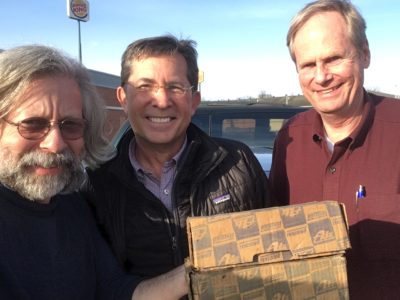
Yes, it was THIS clutch master cylinder that died (Lance center, Dave Gerwig right).
But while I was working on the clutch, Lance White texted me, saying he heard from Safet that I was having trouble with both the clutch and the weather. He said he had a trailer coming down to take his cars back home to Cincinnati, and offered me a space on the trailer and in his warehouse for the winter. There was a lot of synergy and resonance to this, as Louie’s first stop when I left Louisville two years ago was at Lance’s, and as the clutch master I just removed had, in fact, come from Lance. Two years ago, he’d saved my bacon when he met my friend Dave Gerwig and me halfway between Cincinnati and Louisville after Louie’s original clutch master failed as I was about to hit the highway. My conjecture from looking at the box in the adjoining photo is that the master cylinder Lance gave me two years ago was new old stock and the seal had dried out, but it’s just a guess. I texted Benji back, effusively thanking him again for his gracious offer, and confirmed with Lance.
The storage and clutch issues were unfolding simultaneously, so one of the things pressing me to go ahead and do the master cylinder replacement was that Louie had to go somewhere, and it would be much easier if he could be driven instead of pushed, winched, or towed. Plus, having accepted Lance’s generous offer, if the car still needed clutch work when it got to Cincinnati, Safet would probably do it, and that just didn’t seem right.
And thus, after doing all that work to enable me to drive Louie home, I didn’t. Instead, I simply left the car at the Foundation to be picked up in Lance’s trailer and trucked to Cincinnati. Even though the weather seemed to make this a slam-dunk, it felt very strange. From a purely monetary standpoint, having driven down to Greer with Andrew, coming home without Louie seemed wasteful; I’d need to fly down at a later date and pay for hotel rooms and meals all over again. I thought “If, on the drive home, the entire Northeast doesn’t look like the freaking Greenland ice sheet, I’m going to be pissed.”
That evening was the sold-out closing ceremony of the exhibit. It was wonderful. Folks came in from as far as Oregon. Jackie Jouret, Alpina CEO Andreas Bovensiepen, and yours truly were the featured speakers. Huge thanks to Foundation director Scott Dishman, curator Michael Mitchell, and the rest of the Foundation staff for doing such a great job with the nine-month exhibit, and this, the finale.
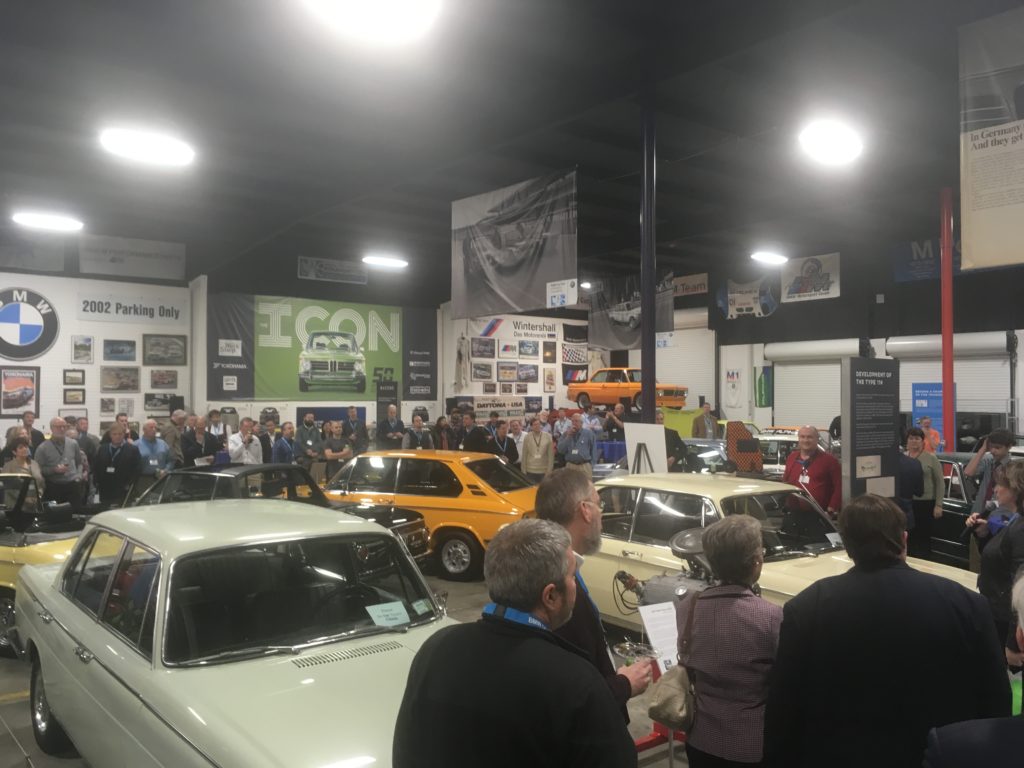
The sold-out closing celebration was great.
The next morning, Andrew and I headed north in his X3. I expected that we’d make use of the AWD and snow tires, but on most of the two-day drive home, the skies and roads were clear, though it was bitterly cold. I began to think I’d called it wrong. It was only when we crossed into New York and were headed up the Merritt Parkway, a curvy two-lane road just north of the city, that we started to see heavy road salting. The storm had apparently pulled its punch—accumulations were less than predicted—but when we pulled off the highway and into service plazas, there was the kind of slushy mix that makes you imagine your vintage car screaming like Bennie the Cab in Who Framed Roger Rabbit? (“Oh my god it’s diiiiiiiip…“). The final two miles from I90 to my house in Newton were slushy. And, as Maire Anne had warned, the frigid temperatures had turned the snow in my driveway to concrete and had frozen my garage door shut. So my plan to simply roll The Lama out of the garage and drive Louie in would’ve been problematic if not impossible.
So, for the first 800 miles, I may have felt that I’d wimped out on driving Louie home, but it was the last 150 miles that counted. Go ahead and arrest me for for the fraudulent title of this piece, but it was the right decision.
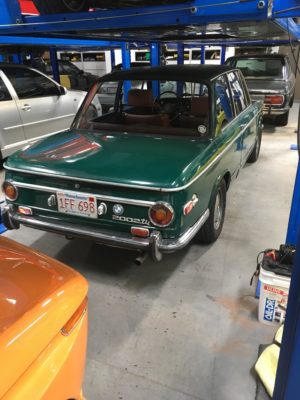
Louie is now safe at Lance White’s.
I’ve missed Louie, and did want him back, but having him at Lance’s ’till spring is a good solution. With the car down there, I can fly down in the spring, join The Rivertown Gearbusters for their spring drive, and then drive home. Or even combine the retrieval with a trip to the Vintage in May. There are several pleasant possibilities. I’m sorry that I didn’t get Louie home again, but I’m grateful that Louie still appears to be fulfilling his role as BMW CCA Ambassador of good will.—Rob Siegel
Rob’s new book, Just Needs a Recharge: The Hack MechanicTM Guide to Vintage Air Conditioning, is available here on Amazon. His previous book Ran When Parked is available here. Or you can order personally inscribed copies of all of his books through Rob’s website: www.robsiegel.com.

